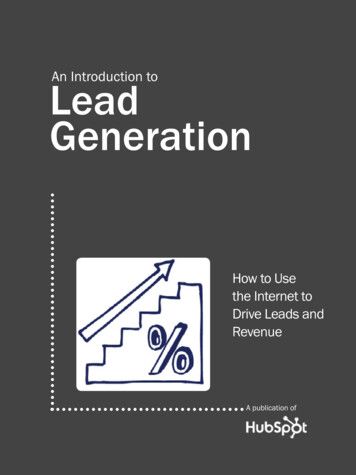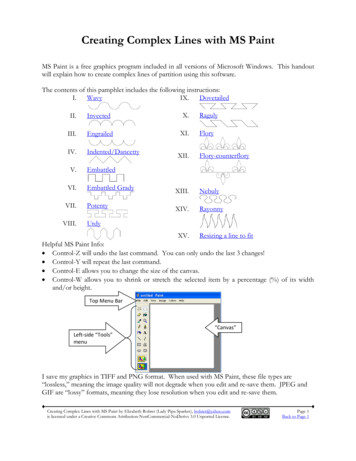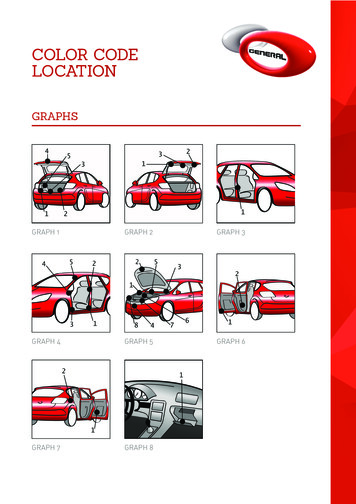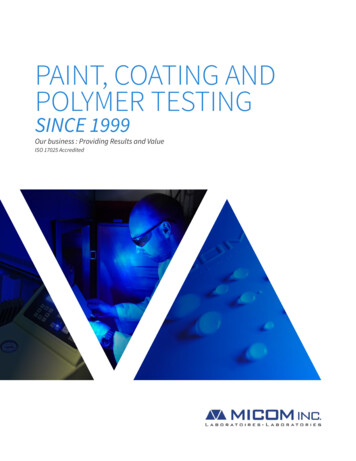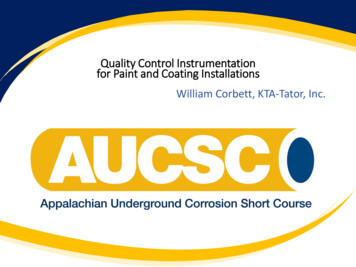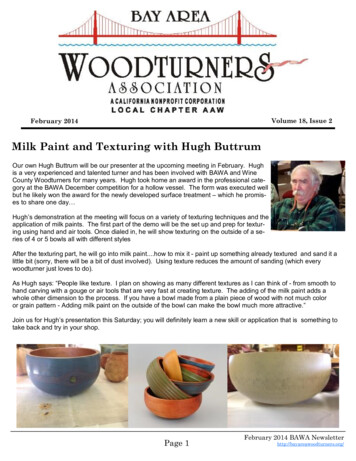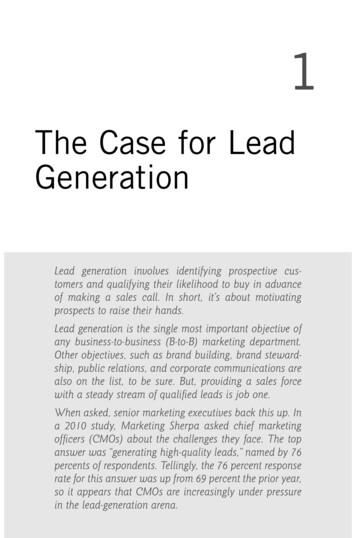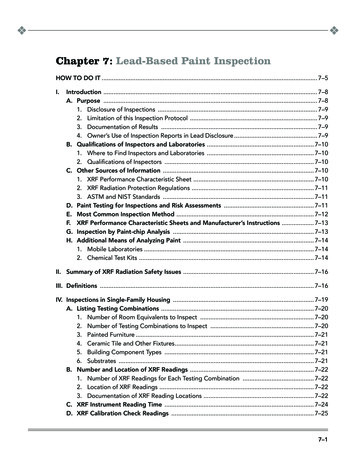
Transcription
Chapter 7: Lead-Based Paint InspectionHOW TO DO IT. 7–5I. Introduction . 7–8A. Purpose . 7–81. Disclosure of Inspections . 7–92. Limitation of this Inspection Protocol . 7–93. Documentation of Results . 7–94. Owner’s Use of Inspection Reports in Lead Disclosure. 7–9B. Qualifications of Inspectors and Laboratories . 7–101. Where to Find Inspectors and Laboratories . 7–102. Qualifications of Inspectors . 7–10C. Other Sources of Information . 7–101. XRF Performance Characteristic Sheet . 7–102. XRF Radiation Protection Regulations . 7–113. ASTM and NIST Standards . 7–11D. Paint Testing for Inspections and Risk Assessments . 7–11E. Most Common Inspection Method . 7–12F. XRF Performance Characteristic Sheets and Manufacturer’s Instructions . 7–13G. Inspection by Paint-chip Analysis . 7–13H. Additional Means of Analyzing Paint . 7–141. Mobile Laboratories . 7–142. Chemical Test Kits . 7–14II. Summary of XRF Radiation Safety Issues . 7–16III. Definitions . 7–16IV. Inspections in Single-Family Housing . 7–19A. Listing Testing Combinations . 7–201. Number of Room Equivalents to Inspect . 7–202. Number of Testing Combinations to Inspect . 7–203. Painted Furniture. 7–214. Ceramic Tile and Other Fixtures. 7–215. Building Component Types . 7–216. Substrates . 7–21B. Number and Location of XRF Readings . 7–221. Number of XRF Readings for Each Testing Combination . 7–222. Location of XRF Readings . 7–223. Documentation of XRF Reading Locations . 7–22C. XRF Instrument Reading Time . 7–24D. XRF Calibration Check Readings . 7–257–1
CHAPTER 7: LEAD-BASED PAINT INSPECTION1. Frequency and Number of Calibration Checks . 7–252. Calibration Check Standard Materials . 7–253. Recording and Interpreting Calibration Check Readings . 7–26E. Substrate Correction . 7–261. When Substrate Correction Is Not Required . 7–272. Substrate Correction Procedure . 7–273. Negative Values. 7–29F. Discarding Readings. 7–29G. Classification of XRF Results . 7–29H. Evaluation of the Quality of the Inspection . 7–301. Direct Observation . 7–312. Immediate Provision of Results . 7–313. Repeated Testing of 10 Surfaces . 7–314. Time-and-Motion Analysis . 7–32I. Documentation in Single-Family Housing . 7–321. Data Forms . 7–322. Electronic Data Storage . 7–323. Final Report . 7–32V. Inspections in Multi-family Housing . 7–36A. Statistical Confidence in Dwelling Unit Sampling . 7–36B. Selection of Housing Units, Common Areas, and Exterior Site Areas. 7–37C. Listing Testing Combinations and Common Areas. 7–41D. Classification of XRF Results in Multi-family Housing . 7–411. Unsampled Housing Units . 7–442. Fewer than 5% Positive Results . 7–45E. Documentation in Multi-family Housing . 7–45VI. Laboratory Testing for Lead in Paint-chip Samples. 7–45A. Number of Samples . 7–46B. Size of Samples . 7–46C. Inclusion of Substrate Material . 7–46D. Repair of Sampled Locations . 7–46E. Classification of Paint-chip Sample Results . 7–47F. Units of Measure . 7–47G. Sample Containers . 7–47H. Laboratory Analysis Methods . 7–48I. Laboratory Selection. 7–49J. Laboratory Report . 7–50VII. XRF Hazards . 7–50A. Licenses and Certifications for Using XRFs with Radioactive Sources. 7–51B. Safe Operating Distance . 7–527–2
CHAPTER 7: LEAD-BASED PAINT INSPECTIONREFERENCES . 7–53ADDENDUM 1: EXAMPLES OF LEAD-BASED PAINT INSPECTIONS. 7–54A. Example of a Single-Family Housing Inspection . 7–54B. Example of Multi-family Housing Inspection. 7–56ADDENDUM 2: DATA COLLECTION FORMS . 7–61 Form 7.1 Single Family Housing LBP Testing Data Sheet – Blank Form 7.1Single Family Housing LBP Testing Data Sheet – Completed Form 7.2Calibration Check Test Results – Blank Form 7.2Calibration Check Test Results – Completed Form 7.3Substrate Correction Values – Blank Form 7.3Substrate Correction Values – Completed Form 7.4Selection of Housing Units – Blank Form 7.4 Selection of Housing Units – Completed Form 7.5Multi-family Housing LBP Testing Data Sheet – Blank Form 7.5Multi-family Housing LBP Testing Data Sheet – Completed Form 7.6Multi-family Housing: Component Type Report – Blank Form 7.6Multi-family Housing: Component Type Report – CompletedADDENDUM 3: XRF PERFORMANCE CHARACTERISTICS SHEETS. 7–74FIGURESFigure 7.1 One type of XRF instrument displays its reading of a testing combination. 7–12Figure 7.2 Child’s bed showing teeth marks in painted surface. 7–21Figure 7.3 Multi-family Decision Flowchart. 7–43Figure 7.4 Preparation to take paint chip sample. 7– 46Figure 7.5 Removing paint chip sample. 7–46Figure 7.6 Damage caused by removing paint chip sample. 7–47Figure 7.7 Inspectors must operate XRFs at safe distance from others. 7–52TABLESTable 7.1 Examples of Interior and Exterior Building Component Types. 7– 18Table 7.2 Examples of Distinct Testing Combinations. 7– 19Table 7.3 Number of Units to Be Tested in Multi-family Building or Developments. 7–387–3
CHAPTER 7: LEAD-BASED PAINT INSPECTIONIntentionally Left Blank7–4
CHAPTER 7: LEAD-BASED PAINT INSPECTIONChapter 7: Lead-BasedPaint InspectionHow to Do It1. See Chapters 3, 5 and 16 for guidance on when a lead-based paint inspection is appropriate. A lead-basedpaint inspection will determine: Whether lead-based paint is present in a house, dwelling unit, residential building, housingdevelopment, or child-occupied facility, including common areas and exterior surfaces; and If present, which building components contain lead-based paint.The U.S. Department of Housing and Urban Development (HUD) and the U.S. Environmental ProtectionAgency (EPA) define an inspection as a surface-by-surface investigation to determine the presence of leadbased paint and the provision of a report explaining the results of the investigation. The sampling protocols in this chapter fulfill that definition.2. The client should hire a certified (licensed) lead-based paint inspector or risk assessor (see 40 CFR part 745).Lists of certified lead-based paint inspectors and risk assessors can be obtained from the EPA website at:www.epa.gov/oppt/lead/pubs/traincert.htm. Laboratories recognized by EPA, under its National LeadLaboratory Accreditation Program (NLLAP), for analysis of lead in paint can also be found at www.epa.gov/oppt/lead/pubs/nllap.htm.3. The inspector should use the HUD/EPA standard for lead-based paint of equal to or greater than 1.0 mg/cm2or 0.5% by weight, as defined by Title X of the Housing and Community Development Act of 1992 (unlessHUD and EPA have lowered the standard). If the applicable standard in the jurisdiction is more stringent, theprocedures in this chapter will need to be modified. For purposes of the HUD/EPA Lead-Based Paint DisclosureRule, 1.0 milligrams per square centimeter (mg/cm2) or 0.5% by weight are the standards that must be used(see Appendix 6) as of the publication of this edition of these Guidelines. If a State, Tribe or local governmenthas an EPA-authorized plan for certifying lead-based paint inspectors and has lower lead standards, thoselower lead standards would apply to inspections (but not to the Lead Disclosure Rule; paint with lead below thefederal threshold is not considered lead-based paint for purposes of that Rule). There are other analytical techniques that may be used by a laboratory with NLLAP recognition for analysisof lead in paint.4. Obtain the XRF Performance Characteristic Sheet (PCS) for the X-Ray Fluorescence (XRF) lead paint analyzerto be used in the inspection. It will specify the ranges where XRF results are positive, negative or inconclusive,the calibration check tolerances, and other important information. Only devices with a posted PCS may beused for lead paint inspections. If you use a XRF without a current PCS, or do not follow the requirementsof the PCS, the work will be considered invalid, and not an inspection or paint testing, as applicable, andthe work will have to be re-done. To obtain the appropriate XRF Performance Characteristic Sheet, contactthe National Lead Information Center Clearinghouse (1-800-424-LEAD) or download it from the Internet s.pdf. XRF Performance Characteristic Sheets have beendeveloped by HUD and EPA for most commercially available XRFs. (Hearing- or speech-challenged individualsmay access this number through TTY by calling the toll-free Federal Relay Service at 800-877-8339.) Reportlead paint amounts in mg/cm2 because this unit of measurement does not depend on the number of layers of7–5
CHAPTER 7: LEAD-BASED PAINT INSPECTIONnon-lead-based paint and can usually be obtained without damaging the painted surface. All measurementsof lead in paint should be in mg/cm2, unless the surface area cannot be measured or if all paint cannot beremoved from the measured surface area. In such cases, concentrations may be reported in weight percent (%)or parts per million by weight (ppm).5. If the XRF instrument has a radioactive source, follow the radiation safety procedures explained in thischapter, and as required by the U.S. Nuclear Regulatory Commission and applicable State and localregulations when using XRF instruments.6. Take at least three calibration check readings before beginning the inspection. Additional calibration checkreadings should be made at least every 4 hours, after inspection work has been completed for the day, oraccording to the manufacturer’s instructions, whichever is most frequent. If the instrument is to be turnedoff during the course of an inspection, calibration checks should always be done before the instrument isturned off and again after it has been warmed up (calibration checks do not need to be done each time aninstrument enters an automatic “sleep” state while still powered on).7. When conducting an inspection in a multi-family housing development or building, obtain a complete list of allhousing units, common areas, and exterior site areas. Determine which can be grouped together for inspectionpurposes based on similarity of construction materials and common painting histories. In each group of similarunits, similar common areas, and similar exterior sites, determine the minimum number of each to be inspectedfrom the tables in this chapter. Random selection procedures are explained in this chapter.8. For each unit, common area, and exterior site to be inspected, identify all testing combinations in each roomequivalent. A testing combination is characterized by the room equivalent, the component type, and thesubstrate. A room equivalent is an identifiable part of a residence (e.g., room, house exterior, foyer, etc.).Painted surfaces include any surface coated with paint, shellac, varnish, stain, paint covered by wallpaper, orany other coating. Wallpaper should be assumed to cover paint unless building records or physical evidenceindicates no paint is present.9. Take at least one individual XRF reading on each testing combination in each room equivalent. For walls, takeat least four readings (one reading on each wall) in each room equivalent. A different visible color does notby itself result in a separate testing combination. It is not necessary to take multiple XRF readings on thesame spot, as was previously recommended, unless the PCS requires such for the XRF instrument being used.10. Determine whether to correct the XRF readings for substrate interference by consulting the XRF PerformanceCharacteristic Sheet. If test results for a given substrate fall within the substrate correction range, takereadings on that bare substrate scraped completely clean of paint, as explained in Section IV.E of this chapter.11. Classify XRF results for each testing combination. Readings above the upper limit of the inconclusive range areconsidered positive, while readings below the lower limit of the inconclusive range are considered negative.Readings within the inconclusive range (including its boundary values) are classified as inconclusive. Someinstruments have a threshold value separating ranges of readings considered positive from readings considerednegative for a given substrate. Readings at or above the threshold are considered positive, while readingsbelow the threshold are considered negative.12. In single-family housing inspections, all inconclusive readings must be confirmed in the laboratory, unless theclient wishes to assume that all inconclusive results are positive. Such an assumption may reduce the costof an inspection, but will probably increase subsequent abatement, interim control, and maintenance costs,because laboratory ana
7–5 CHAPTER 7: LEAD-BASED PAINT INSPECTION Chapter 7: Lead-Based Paint Inspection How to Do It 1. See Chapters 3, 5 and 16 for guidance on when a
